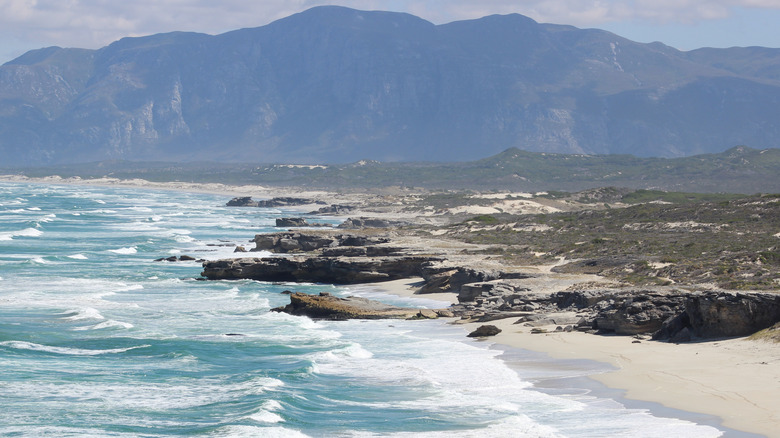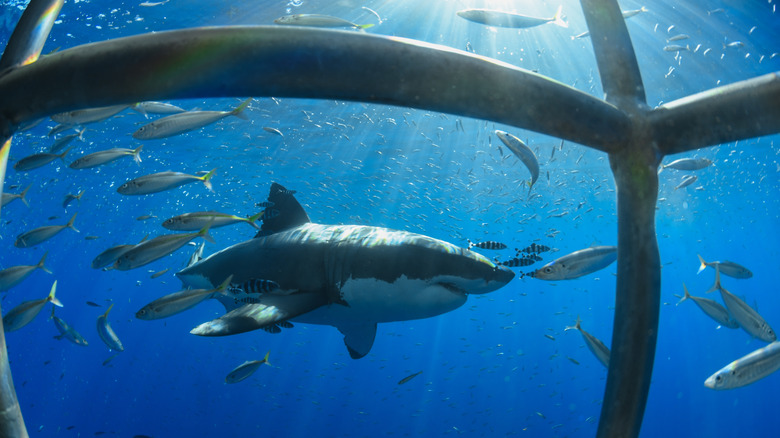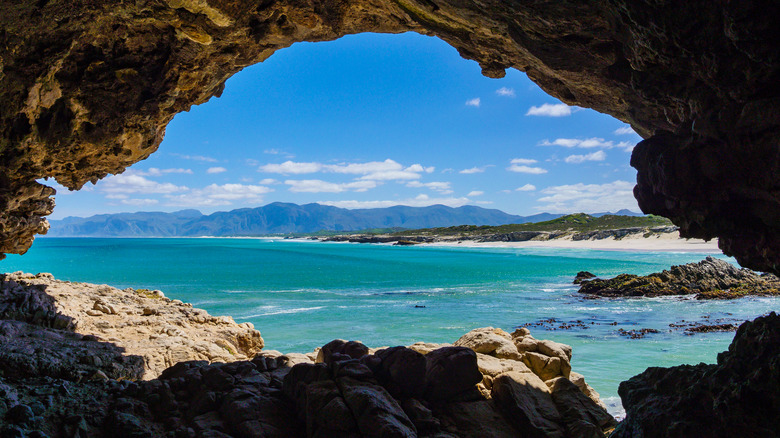These South African Beaches Are Considered Some Of The Most Dangerous In The World
Gansbaai, a fishing town in South Africa's Western Cape, is known for its diverse coastlines featuring cliffs, caves, rocky inlets, and ancient milkwood forests. In addition, the beaches around Gansbaai are picturesque marvels. Long stretches of white sand with panoramic views of the Indian Ocean are ideal for strolling, sunbathing, and family picnics. However, swimming is risky at these magnificent beaches, as hidden dangers lurk offshore: very large sharks, including 6- to 10-foot-long bronze whaler sharks along with great whites, whose average length ranges from 11 to 16 feet.
In fact, so many great whites have been sighted in the waters around Gansbaai that it's become known as the great white shark capital of the world. The predators are drawn to the area because of the population of 60,000 cape fur seals that breed several miles away on Geyser Rock. Blending spine-tingling danger, small-town charm, and breathtaking beauty, Gansbaai is a one-of-a-kind destination. Many come to experience the thrill of shark-cage diving, as Gansbaai is the only place in the world that offers cage-diving trips on a daily basis, as long as weather is not a factor.
Shark-cage diving in Gaansbai
Gansbaai's unique shark cage-diving trips allow for close encounters with big sharks. The South African Marine and Coastal Management Department of Environmental Affairs and Tourism regulates the shark-cage diving industry to ensure that these trips comply with codes of conduct and safety regulations. While populations of great whites have been declining in the area since 2017, the awesome predators are still sighted on trips, along with the bronze whaler sharks, which are also fascinating to watch. The hair-raising experience begins with a boat ride out to the viewing location. After a safety debriefing, divers enter the cage. On the popular breath-hold trips, only a portion of the cage gets submerged, allowing divers to keep their heads above the ocean surface and then dip themselves underwater while holding their breath to witness any nearby sharks. This setup doesn't require sophisticated diving equipment such as oxygen tanks and regulators, making it accessible to a wider range of people, including those who have never gone diving before.
The crew on shark cage-diving trips are typically experienced professionals who are knowledgeable about shark behavior. They provide insights into shark behavior, their conservation status, and the importance of respecting these creatures in their natural environment. Beyond the thrill, shark-cage diving in Gansbaai is a mind-expanding experience that often changes participants' views of sharks forever, impressing upon them that sharks play a critical role in the ocean's ecosystem.
Other things to do in Gaansbai
Visitors should know, however, that there's much more to Gansbaai than its shark-infested waters. The waters around Gansbaai are also a haven for southern right whales, which can be viewed from lookout points along the shore between June and September. Boat-based tours are another great way to see an amazingly wide variety of marine life. On boat tours from Gansbaai to Dyer Island, visitors have opportunities to see southern right whales, humpback whales, and Bryde's whales along with great white sharks, African penguins, cape fur seals, and a variety of sea birds. These tours aren't as adrenaline-filled as shark cage diving, but they are thrilling nonetheless.
Another must-visit is the Klipgat Cave in the Walker Bay Nature Reserve. This site, rich in archaeological significance, offers a glimpse into the lives of our Stone Age ancestors, who inhabited the cave from 50,000 to 80,000 years ago. The cave is also a stunning natural wonder, offering sweeping views of the turquoise ocean. In sum, Gansbaai is a treasure trove of experiences that goes well beyond shark encounters. It's a destination that promises adventure and exhilaration but also relaxation and serenity.


